In the game of cricket, the cricket pitch consists of the central strip of the cricket field between the wickets. It is 22 yd (20.12 m) long and 10 ft (3.05 m) wide. The surface is flat and is normally covered with extremely short grass, but can be completely dry or dusty soil with barely any grass or, in some circumstances, made from an artificial material. Over the course of a cricket match, the pitch is not repaired or altered other than in special circumstances - meaning that it will change condition. Any grass on the pitch in the game's first over, for example, may have disappeared by the twentieth over due to wear.
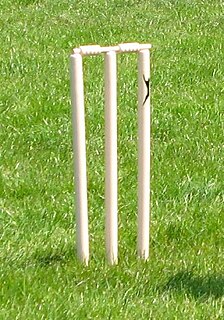
In cricket, the term wicket has several meanings:

This is a general glossary of the terminology used in the sport of cricket. Where words in a sentence are also defined elsewhere in this article, they appear in italics. Certain aspects of cricket terminology are explained in more detail in cricket statistics and the naming of fielding positions is explained at fielding (cricket).
Cricket is a sport that generates a variety of statistics.

The Border–Gavaskar Trophy is a Test cricket series played between India and Australia. It is played via the International Cricket Council's future tours program, every two years.
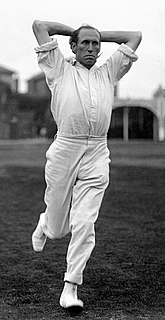
John Barton "Bart" King was an American cricketer, active in the late 19th and early 20th centuries. King was part of the Philadelphia team that played from the end of the 19th century until the outbreak of World War I. This period of cricket in the United States was dominated by "gentlemen cricketers"—men of independent wealth who did not need to work. King, an amateur from a middle-class family, was able to devote time to cricket thanks to a job set up by his teammates.

In cricket, a dismissal occurs when a batsman's period of batting is brought to an end by the opposing team. It is also known as the batsman being out, the batting side losing a wicket, and the fielding side taking a wicket. The ball becomes dead, and the dismissed batsman must leave the field of play permanently for the rest of their team's innings, and is replaced by a teammate. A team's innings ends if 10 of the 11 team members are dismissed—as players bat in pairs, when only one person is undismissed it is not possible for the team to bat any longer. This is known as bowling out the batting team, who are said to be all out.
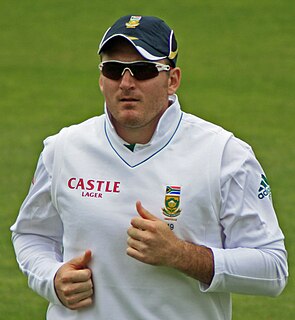
The captain of a cricket team, often referred to as the skipper, is the appointed leader, having several additional roles and responsibilities over and above those of the other players. As in other sports, the captain is usually experienced and has good communication skills, and is likely to be one of the most regular members of the team, as the captain is responsible for the team selection. Before the game the captains toss for innings. During the match the captain decides the team's batting order, who will bowl each over, and where each fielder will be positioned. While the captain has the final say, decisions are often collaborative. A captain's knowledge of the complexities of cricket strategy and tactics, and shrewdness in the field, may contribute significantly to the team's success.

Baseball and cricket are the best-known members of a family of related bat-and-ball games. Both have fields that are 400 feet (120 m) or more in diameter between their furthest endpoints, offensive players who can hit a thrown/"bowled" ball out of the field and run between safe areas to score runs (points) at the risk of being gotten out, and have a major game format lasting about 3 hours.
In the sport of cricket, a declaration occurs when a captain declares his team's innings closed and a forfeiture occurs when a captain chooses to forfeit an innings without batting. Declaration and forfeiture are covered in Law 15 of the Laws of Cricket. This concept applies only to matches in which each team is scheduled to bat in two innings; Law 15 specifically does not apply in any form of limited overs cricket.
The result in a game of cricket may be a "win" for one of the two teams playing, or a "tie". In the case of a limited overs game, the game can also end with "no result" if the game can't be finished on time, and in other forms of cricket, a "draw" may be possible. Which of these results applies, and how the result is expressed, is governed by Law 16 of the laws of cricket.

Scoring in cricket matches involves two elements – the number of runs scored and the number of wickets lost by each team. The scorer is someone appointed to record all runs scored, all wickets taken and, where appropriate, the number of overs bowled. In professional games, in compliance with the Laws of Cricket, two scorers are appointed, most often one provided by each team.

In the sport of cricket, two batsmen always bat in partnership, although only one is a striker at any time. The partnership between two batsmen will come to an end when one of them is dismissed or retires, or the innings comes to a close (usually due to victory being achieved, a declaration, a time or over limit being reached, or the match being abandoned in mid-innings for inclement weather or, exceptionally, dangerous may be between more than two batsmen, if one of the original batsmen is retired not out, since the particular numbered wicket will not have fallen yet.

A delivery or ball in cricket is a single action of bowling a cricket ball toward the batsman. Once the ball has been delivered, batsmen may attempt to score runs, with the bowler and other fielders attempting to stop this by getting the batsmen out. When the ball becomes dead, the next delivery can begin.
Armchair cricket is a card game that is inspired by the bat and ball sport cricket. It is played by either two or four people. Depending on the version of the game being played, a game can last a few minutes to several hours. It was produced commercially in England but is no longer made.
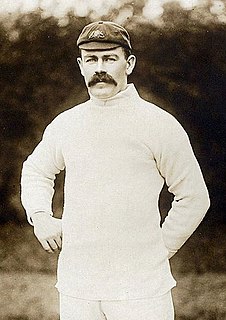
The Australian cricket team toured England during the 1902 English cricket season. The five-Test series between the two countries has been fondly remembered; in 1967 the cricket writer A. A. Thomson described the series as "a rubber more exciting than any in history except the Australia v West Indies series in 1960–61". Australia had won the previous three Test rubbers between the two countries, and now won their fourth successive series, by two matches to one with two draws. In the process they "beat the records of all their predecessors in the country" by losing only two of 39 matches during the tour, their defeats being against England in the Fifth Test and in the first of their two fixtures against Yorkshire. The remaining 37 matches gave 23 wins for Australia and 14 draws.
The New Zealand cricket team toured England in the 1949 season. The team was the fourth official touring side from New Zealand, following those in 1927, 1931 and 1937, and was by some distance the most successful to this date. The four-match Test series with England was shared, every game ending as a draw, and of 35 first-class fixtures, 14 were won, 20 drawn and only one lost.
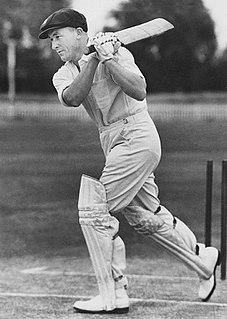
Ron Hamence was a member of Donald Bradman's famous Australian cricket team of 1948, which toured England and was undefeated in its 34 matches. As a result of this unprecedented feat by a Test side touring England, the team earned the nickname The Invincibles.

Ian Johnson was a member of Donald Bradman's famous Australian cricket team, which toured England in 1948. Bradman's men went undefeated in their 34 matches; this unprecedented feat by a Test side touring England earned them the sobriquet The Invincibles.












